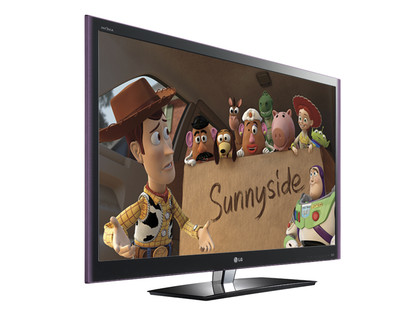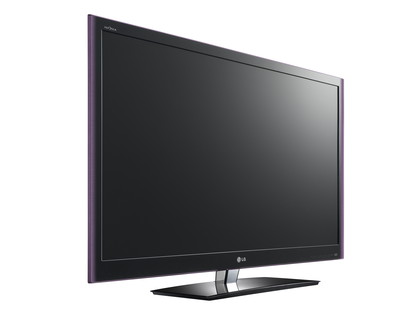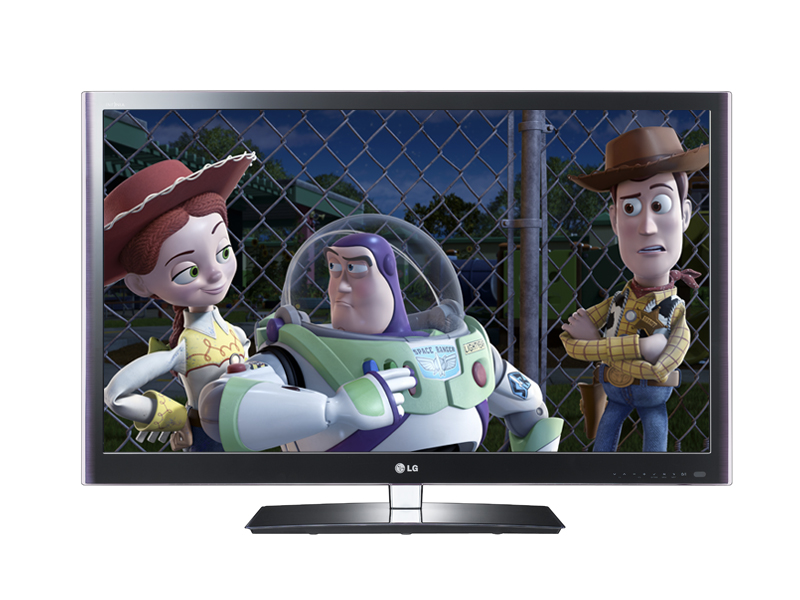Why you can trust TechRadar

In keeping with most 2011 TVs, the LG 42LV550T uses an edge LED lighting system. This immediately delivers an obvious design boost, since the set's very trim around the back compared with most conventional LCD TVs. It should also deliver energy benefits – LG claims its edge LED TVs use as much as 40% less energy than normal CCFL lighting systems.
The LG 42LV550T's design looks pretty nice from the front, too, with a reasonably narrow bezel that's given extra swagger by a glossy finish and the way it tapers to a point at its extremities.
TVs as slim and light (13.2kg) as the LG 42LV550T obviously lend themselves nicely to wall hanging, so it's nice to find that all of its connections have been arranged so that you can access them from the side or bottom of the TV; they don't just point straight out.
The connections in question are extensive. Four HDMIs lead the charge, joined among other things by a pair of USB ports, a D-Sub PC port, a LAN port, a component video input and an RS-232 control port that people building integrated home networks will appreciate.
The USBs can be used for either making the TV Wi-Fi ready via an optional dongle, or else playing back a healthy variety of music, photo and video file formats – including Xvid, DivX and MKV.
As for the LAN, this serves no less than three potential functions. First, it's there as mandatory but currently pointless support for the set's built-in Freeview HD tuner. Second, it provides access to LG's new Smart TV online content service, which will be covered in detail in a moment. Finally, it allows you to stream files stored on connected PCs or Macs via the rather pleasantly presented and flexible PLEX interface.

LG is currently the only brand using PLEX, and in earlier reviews it caused quite a few problems, particularly when trying to get the TV talking to Apple Macs.
Rather brilliantly, though, these previous Mac communication problems were fixed on the LG 42LV550T, which hooked up with a PLEX-enabled Mac as soon as it was added to the network. It then proceeded to work very stably, even when streaming HD camcorder files.
LG's Smart TV service, meanwhile, impresses once more with the quality of its presentation and the leap in its content level versus last year's models. Headline services comprise an open web browser, BBC iPlayer, Acetrax movies, VTuner internet radio, YouTube, Picasa and the inevitable Facebook and Twitter apps.
Other so-called 'Premium' apps include Woomi for TV, Funspot for games, mlb.tv for watching baseball, Dailymotion, Google Maps, Viewster, iConcerts, Al Jazeera, CineTrailer, AUPEO! Personal radio and AccuWeather.
There's also a vast quantity of second-tier apps – around 115 at our latest count – covering games, lifestyle, education, news/information and entertainment. The vast majority of these secondary, download-them-if-you-want-them apps are of niche interest, to say the least. So much so that it's hard to imagine anyone filling the set's 300MB of provided app memory particularly fast.
One other little negative point to raise here, too, is that during the review process, some of the Premium services took quite a long time to load.
The 42LV550T joins the majority of LG TVs in receiving the endorsement of the Imaging Science Foundation (ISF). This indicates that the TV has enough picture set-up options to be professionally calibrated.
If you want to have a go at in-depth calibration for yourself, the sort of fine-tuning options available include adjustments for the contrast and brightness of the RGB colour elements; the colour and tone settings for the RGBCMY colour elements; backlight control; gamma presets and 2pt or 10pt white balance adjustment.
The 'Advanced' picture sub-menu also contains all sorts of processing options, such as MPEG and standard noise reduction tools, a dynamic contrast system, a black level booster and a 'Super Resolution' feature for increasing the picture's sharpness.
To be honest, though, most of these options, aside perhaps from the Dynamic Contrast one, are best left turned off, especially if you're watching an HD source, because they can cause the picture to look processed.
The last picture adjustments of note are an optional Local Dimming system that can control portions of the edge LED lights separately to enhance contrast performance, and various settings for the set's TruMotion processing. There's even a manual TruMotion mode where you can adjust how hard the processing works on judder and blur separately.
The last thing to quickly mention on the LG 42LV550T's features is the MCI 500Hz figure noted earlier. The 500Hz bit doesn't refer to an actual image refresh rate of 500Hz in the traditional sense. In fact, the native refresh rate is 100Hz, with the other 400Hz being delivered by a combination of a scanning backlight and the set's motion processing.
Current page: LG 42LV550T: Features
Prev Page LG 42LV550T: Overview Next Page LG 42LV550T: PerformanceJohn has been writing about home entertainment technology for more than two decades - an especially impressive feat considering he still claims to only be 35 years old (yeah, right). In that time he’s reviewed hundreds if not thousands of TVs, projectors and speakers, and spent frankly far too long sitting by himself in a dark room.

